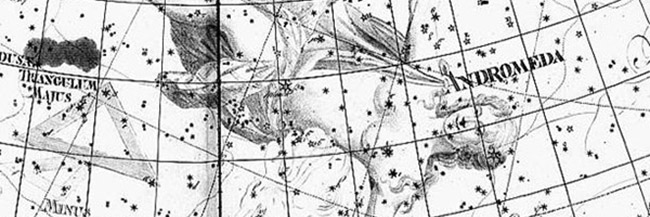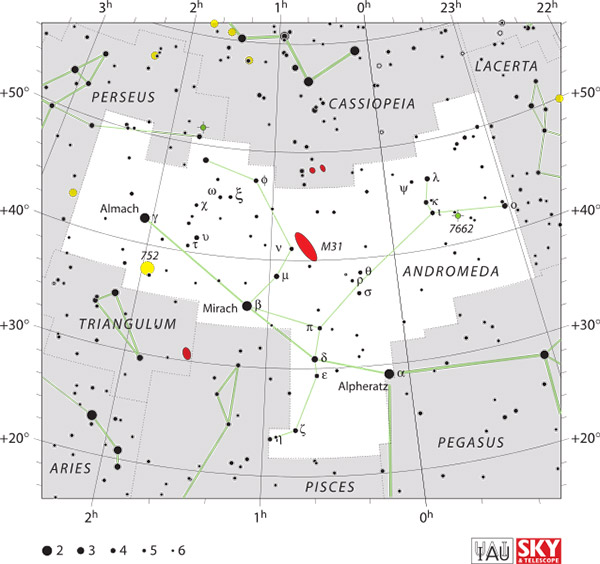Andromeda – Constellation Facts

Andromeda is the 19th biggest constellation and was first listed about 2,000 years ago by Ptolemy, who was a Greco-Roman scientist. It can be viewed from both the Northern and Southern hemispheres but is actually located in the first quadrant of the Northern hemisphere at latitudes between +90° and -40°. This fascinating astronomical wonder is also part of the Perseus group of constellations which includes Cassiopeia and Pegasus.
Constellation Characteristics
Andromeda got her name from being the wife of Perseus who was a Greek hero. This constellation is also referred to as the Chained Maiden, Persea (wife of Perseus), or Cepheis (daughter of Cepheus). This relatively simple grouping of stars can be best viewed between the months of February to August in the Northern hemisphere and between October and December in the Southern hemisphere.

IAU and Sky & Telescope magazine (Roger Sinnott & Rick Fienberg), CC BY 3.0, via Wikimedia Commons
By IAU and Sky & Telescope magazine (Roger Sinnott & Rick Fienberg) ([1]) CC BY 3.0, via Wikimedia CommonsPlanetary Systems
Andromeda is home to many deep star galaxies known as Messiers. Check them out.
- Andromeda Galaxy (Messier 31): also referred to as the ‘Great Andromeda Nebula,’ it is approximately 2.5 million light-years away and is considered a spiral galaxy. To the naked eye it is the farthest object in the night sky, but it is the closest spiral galaxy to the Milky Way. In addition, the Andromeda Galaxy contains approximately a trillion stars – the Milky Way has around 400 billion stars.
- Le Gentil (Messier 32): this ‘dwarf elliptical’ galaxy was first discovered in 1749 by a French astronomer by the name of, Guillaume Le Gentil. It is quite small, but shines very brightly and can be viewed through a small telescope. Interestingly, it contains mostly old stars without any new ones being formed.
- Messier 110: located 2.9 million light-years away, M110 is considered a dwarf elliptical galaxy and contains 8 globular clusters in the halo around it. M110 is also showing signs of new star formations.
- The Blue Snowball Nebula or Caldwell 22 (NGC 7662): is a planetary nebula. It has a faint variable star and a bluish dwarf at its center. Surrounding this wonder is a blue disk. It is estimated to be around 1,800 light years in distance.
Main Stars
- Alpheratz (Alpha Andromeda) is the brightest star (which will be discussed later in detail).
- Mirach (Beta Andromeda) it is located on Andromeda’s “left hip” and is part of the girdle. It is around 200 light years away and is considered a semi-regular variable star. It shines a cool bright red and is 1,900 times brighter than the sun.
- Almach (Gamma Andromeda) Arabic for the “desert lynx” this star is the 3’rd brightest in Andromeda. It has two color components to it – a golden-yellow giant and a blue companion.
- Delta Andromedae is about 101 light years away and is a double star – the brighter is a K-type giant, while the dimmer is a white dwarf.
- Iota Andromedae is 503 light years away and has a bluish-white shine. It is classified as a B-type main sequence dwarf.
- Upsilon Andromedae is a binary star with a faint red dwarf and a yellow-white dwarf. It is about 3.1 billion years old.
- Adhil is Arabic (al-dhayl) which literally means “tail” and is about 196 light-years away.
- Nembus (51 Andromedae) this K-type giant is orange in color and shines the fifth brightest in Andromeda.
- Mu Andromedae is an A-type white dwarf that is located 136 light-years from Earth.

Johann Elert Bode, Uranographia, Public domain, via Wikimedia Commons
Andromeda chained to a rock, depicted in the Uranographia of Johann Bode (1801)Most Shining Star
Out of all the stars that make up the Andromeda constellation, none shine brighter than Alpheratz (Alpha Andromedae). This binary star is classified as a B8 subgiant and shines with a hot-blue color. The brighter star making up this binary is made up of extreme levels of manganese and mercury and burns with a surface temperature of 13,800 K. Alpheratz can also claim to be the brightest mercury-manganese star known so far. The companion star in Alpheratz is 10 times brighter than our sun and also much larger. These stars orbit each other in 96.7 days.
Mythology & History
Andromeda is surrounded in Greek mythology. It was thought that Andromeda was the daughter of King Cepheus and Queen Cassiopeia – who boasted about her own beauty to the sea nymphs. The nymphs became enraged at the Queen’s arrogance and complained to Poseidon. In retaliation, the sea god sent a sea monster to flood the King’s land. The only way he could return his land to its once glorious splendor was to sacrifice his daughter to Cetus. Andromeda was chained to a rock and left to die; however, Perseus came along and saved her (they were later married and had 6 children).
Andromeda is a fascinating constellation, so the next time you are gazing into the night sky, be sure to search out this intriguing figuration of stars.
